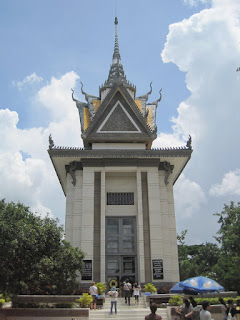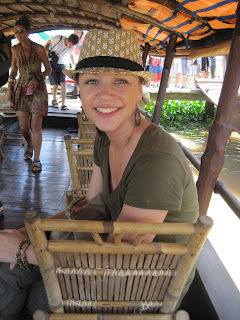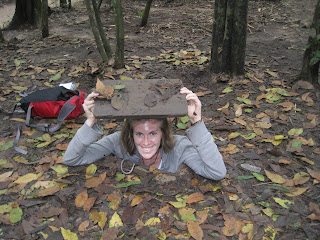 The first day of the trip we went to see the Tuol Sleng Genocide Museum in the city. It is an old high school that was turned into a prison by the Khmer Rouge from 1975-1979. It was a very open building with a pretty green courtyard, so at first I could imagine it as a normal high school. But the rooms held remnants and pictures of life in the prison, including photos of many of the prisoners. They think up to 20,000 people passed through the prison, and the Khmer Rouge did a thorough job of documenting them all. They also had many of the rooms split up into tiny solitary cells and had examples of the devices used for torture.
The first day of the trip we went to see the Tuol Sleng Genocide Museum in the city. It is an old high school that was turned into a prison by the Khmer Rouge from 1975-1979. It was a very open building with a pretty green courtyard, so at first I could imagine it as a normal high school. But the rooms held remnants and pictures of life in the prison, including photos of many of the prisoners. They think up to 20,000 people passed through the prison, and the Khmer Rouge did a thorough job of documenting them all. They also had many of the rooms split up into tiny solitary cells and had examples of the devices used for torture.After the prisoners were tortured and interrogated in the prison, they were taken to the nearby Killing Fields, where as the name suggests they were killed and buried in mass graves. The Khmer Rouge were communists who wanted this perfect agrarian society. They abolished money, sent people out of the cities to the country and into forced labor camps. They targeted anyone suspected of having a connection with the old government and intellectuals. It is thought that they executed over 200,000 people, but that over 2million died from disease and starvation. It's a very tragic and VERY recent past, so it's a hard thing to see.
This is a stupa that was built to memorialize those killed here. Inside are many of the bone remains and clothing from the prisoners.

 After seeing the sad sites of Phnom Penh, we went for a more cheerful trip to the Grand Palace. It was a lot like the Grand Palace in Thailand, but also had some interesting French influences.
After seeing the sad sites of Phnom Penh, we went for a more cheerful trip to the Grand Palace. It was a lot like the Grand Palace in Thailand, but also had some interesting French influences.

 The river front was very pretty. We ate along here and had some drinks at night.
The river front was very pretty. We ate along here and had some drinks at night. I found out just before leaving for my trip that I have a cousin who lives in Phnom Penh. My dad and her dad are cousins so I have no idea what that technically makes us...second cousins? They took me and Pam to this great restaurant that trains street kids how to work in restaurants. It was a really cool place with delicious food. It's amazing how small the world is sometimes!
I found out just before leaving for my trip that I have a cousin who lives in Phnom Penh. My dad and her dad are cousins so I have no idea what that technically makes us...second cousins? They took me and Pam to this great restaurant that trains street kids how to work in restaurants. It was a really cool place with delicious food. It's amazing how small the world is sometimes!




















































